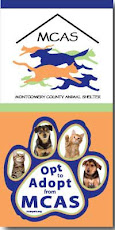
On Thursday, July 23, 2009, one of our local papers in Montgomery County, Texas, The Conroe Courier, ran an editorial entitled, "How deep will we dig to spare our strays?" You can read the piece here.
Here is the second draft of my response:
Dear Editors:
In regards to the Editorial “How deep will we dig to spare strays?” (July 23, 2009) I have five proposals:
1) I invite the Editors to come and visit the Montgomery County Animal Shelter to witness first-hand how many people enter the doors of the Shelter to surrender animals. Listen to the stories (some heart-wrenching, others just poor excuses) as to why people have chosen to bring these animals to the Shelter. And be sure to count how many animals are arriving—the Editors might be astonished to realize that during a single day the MCAS may do intakes on more than 120 animals. Many are not “strays.” I’m sure the Shelter Staff would appreciate any advice the Editors could give on how to stem the tide of disposable animals. Unfortunately, when a citizen arrives with a box of kittens or a crate of unwanted puppies, this can't be undone.
2) I invite the Editors to step up as Shelter volunteers. Wear old clothes, tennis shoes or rubber boots, and bring gloves (latex are best) and your own sturdy leashes. Join the already over-worked (not to mention totally unpaid) Shelter volunteers in cleaning kitty litter boxes, wiping down cat cages, swabbing out concrete dog kennels, bathing puppies and washing soiled, stinky towels. Experience for yourselves the joy of a grateful dog who pines for a kind touch or a cat’s contented purr as you rub its back. These animals may be “strays” but they are living creatures, too.
3) I invite the Editors to set a wonderful example for our community by generously contributing their donations (cash is good) to the fine non-profit groups that support the Shelter, including the Friends of the Montgomery County Animal Shelter (www.fmctas.org) or The Woodlands Dog Park (www.thewoodlandsdogparkclub.org). These groups donate thousands of dollars each year to alleviate the suffering of the sick and injured animals that arrive at the Shelter every day. All donations are tax-deductible, of course.
4) I invite the Editors to donate items such as canned dog or puppy food, canned kitten food, bleach, PineSol cleaners, laundry soap, dry dog food, puppy training pads, paper towels, and Dawn dish-washing soap—we need these basic supplies to provide safe conditions for not only the animals but for the people (many of whom are residents of our county) who come to search for a lost pet or find a new pet.
5) I invite the Editors to sponsor Pet Adoption Events. Please, do more than just run a couple column inches the day before. Instead, I suggest that all the Editors band together as volunteers and have The Courier underwrite a series of fun and educational Pet Adoption events. Adoption Events are one of the best venues to educate the public about the importance of spaying and neutering pets. The Editor-volunteers can arrange for the location and permits, acquire and erect tents or canopies, and set up dog crates, tables and chairs. The Editors can make and post signs and send out flyers, and they can join the Shelter volunteers at the Adoptions. The work done by the Editor-Volunteers would make it possible for the regular Shelter volunteers (who do all the above already) to focus on getting more animals out of the Shelter so that the pet-loving public can interact with them in fun surroundings.
If all of this sounds too daunting, or seems like too much of a commitment to make in the community in which we--Editors, volunteers, tax-paying citizens, stray animals and pets alike--all live, I have one final suggestion:
I encourage the Editors to refrain from acquiring a pet. After all, that pet may one day get lost and might end up in our Shelter, picked up as a “stray.” Sadly, many of our “strays” are obviously well-loved pets—with lush coats, clipped nails, and even collars (but, alas, all too often without tags). If we’re wasting tax-payer money on only “strays,” we certainly wouldn’t want the Editors or their family members to suffer the grief of finding out that their beloved dog or cat ended up the Shelter, thus costing our tax-payers even more money.
I am a resident, voter, and tax-payer who lives in Montgomery County. I am a regular Shelter volunteer. I make cash donations, foster animals and coordinate Adoption Events. I am not nearly as dedicated as many of our Shelter volunteers, but I do what I can. Instead of complaining about money spent on “sparing strays," the Editors should be part of the solution through their volunteer efforts and contributions to our County and City Shelters.
-*- Artwork: Post-digital creation based on the famous "Big-Eyed Puppies" made popular in the late '60s.


















